Lesson of the surrounding world in the 4th grade on the topic “Natural zones of Russia. Forest Zone» prepared using case technology. Case - method - this is a kind of interactive teaching methods that creates a favorable environment in the classroom for practicing the practical skills necessary for students to work competently with various kinds of information; allows you to activate the theoretical knowledge and practical experience of students, their ability to express their thoughts, ideas, suggestions, the ability to listen to an alternative point of view and reasonably express their own. Using this method helps to see the ambiguity of solving problems in real life and develops important qualities for later life, such as the ability to correctly present one's opinion and listen to the opinion of another, sociability, social activity. The class is divided into groups, each group works on its case (set of materials) and performs the proposed tasks. Subsequently, each group reports on the work done.The role of the teacher:Pto help children in finding sources of information, to be the source of information themselves, to encourage students to be active in the lesson.
Methods used in the lesson: analysis of business correspondence, role playing, group discussion, situational exercises.
Type of case method: informational.
Lesson topic «Natural zones of Russia. Forest zone.
The purpose of the lesson: to form in students an idea of the natural zone of forests.
Lesson objectives: to acquaint with the forest zone, its geographical location and climatic conditions; learn the features of the flora and fauna of the forest zone, the economic activity of the population.
Planned results:
Personal UUD: developmotivation for learning activities and the personal meaning of learning,educational and cognitive interest in new educational material,interest in acquiring and expanding knowledge and methods of action, a creative approach to completing tasks; skillmake independent decisions, put forward ideas and defend their judgments;cooperation skills with adults and peers,the ability to self-assessment based on the criteria for the success of educational activities.
Metasubject UUD
Regulatory UUD: determineandformulatethe purpose of the activity in the lesson;to plan,control and evaluatetheir actions in accordance with the taskand conditions for its implementation; in dialogue with the teacher, learn to develop evaluation criteria and determine the degree of success in the performance of their work and the work of other students, based on the existing criteria.
Communicative UUD: learn to work in a groupcooperate in joint problem solving;to formulate own opinion and position;express your point of view and try to substantiate it, giving arguments; learn to respect the position of another, to be able to negotiate.
Cognitive UUD: select the sources of information necessary for solving the educational problem; obtain new knowledge by extracting information presented in various forms (text, table, diagram, illustration, etc.); process the information received: compare and group facts and phenomena, draw conclusions based on the generalization of knowledge; complete enough and convincingly to build an oral statement.
Subject UUD: get an idea of the forest zone; to get acquainted with its geographical position and climatic conditions; learn the features of the flora and fauna of the forest zone, the economic activity of the population.
Equipment: map of natural areas, illustrations depicting the Arctic zone, tundra, cases with materials and tasks, herbarium of forest plants, guide atlases "From Earth to Sky".
During the classes
Organizing time. (Slide 2)
We will watch again today
Draw conclusions and reason.
And so that our lesson goes to everyone for the future,
Get active, friend!
- Join hands, smile, feel the support of each other and wish yourself and others good fruitful work.
2. Actualization of knowledge.
Today we continue our journey around our native land. We have a clear route, we are traveling, exploring the natural areas of Russia. In the course of our research, we got acquainted with two zones of Russia. Name the zones in the order you study them. (Zone of the Arctic deserts, tundra.)(Slide 3)
Why do you think the study of natural zones begins with the northernmost zone - the zone of the Arctic? (The ability to trace the relationship of wildlife from the position of the sun, comparing with more southern zones.)
Do you remember what scheme of influence you drew up? (WITHsun - climate - soil - plants - animals)
Find out the studied zones from the description and correlate them with the corresponding photos.(Slide 4)
Winter in this natural area lasts about six months. Already in October, frosts reach -40 degrees C. Summer is short. The wind smells like flowers. Bumblebees hum above the flowers, and clouds of mosquitoes howl overhead. Can you see the forest - knee-high? Pencil-thin trees in it spread along the ground. Reindeer breeding, hunting, fishing, mining are the occupations of the population.
In summer - a polar day. Summer is very short. All nature is transformed, thousands of birds fly. They settle on rocks free of ice. The hubbub is unimaginable. In addition to birds, a huge number of pinnipeds sail in the summer: sea lions, sea lions, walruses, seals. A person in such conditions is very limited in economic activities - fishing, hunting for sea animals.
3. Creation of a problem situation.
Listen to another description.(Slide 5)
The winter here is severe, with frosts down to -40 degrees C and below, but the summer is warmer and longer than in the tundra. Not only shrubs and herbs can grow here, but also large trees with a deep and powerful root system.
Occupations of the population: hunting, logging, manufacturing goods in factories and factories.
Do you think this description can be attributed to one of the studied zones?
Is there anything in common? (with tundra)
It should be concluded that we are not familiar with this zone, and we have to get acquainted today.
(Slide 6)
5. P stop the purpose of the lesson.
What do you think, what do we have to find out today? (Climate, soils, flora and fauna, environmental problems of the forest zone) (Slide 7)
6. Work on a new topic in groups using case studies.
Group work. The material is independently studied and discussed in groups. If questions arise, the teacher advises.
And now our geographers, botanists, zoologists and ecologists will receive cases with materials and questions and begin to study a new natural area.
case № 1 for geographers (Slide 8)
1) Where is the forest zone stretched?
2) Name the shape of the earth's surface occupied by the natural zone: plain, mountains, hills.
3) Climatic conditions (winter, summer, their duration, temperature, precipitation, winds).
4) What kind of soil is there? Why?
Source 1.
Attextbook O.T. Poglazov "The world around" (p. 124).
Source 2.
Illustrations depicting the forest.
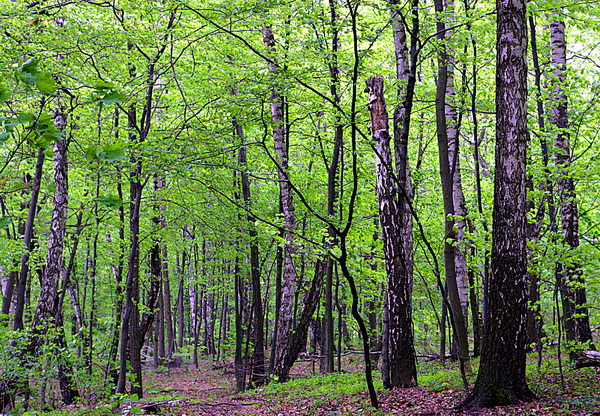
Source 3.
Map of natural areas.
Source 4.
South of the tundra zone is the forest zone. It is marked in green on the map. The forest zone is located in the temperate zone, which means that all four seasons are pronounced, cold winters and warm summers. This largest zone stretches over the East European and West Siberian plains, and also includes a little of the Central Siberian Plateau. There are three parts in this zone: the largest part istaiga , it is shaded in dark green. The taiga makes up almost 90% of the area of the entire forest zone, which occupies more than 1/3 of the territory of Russia. The climate of the taiga is characterized by relatively warm and rather humid summers and cool, and sometimes cold winters. The air temperature in summer often exceeds +30 °С; in winter, frosts reach 30 ... 50 ° С. In Eastern Siberia, hot and dry summers, severe and little snowy winters are observed.
Mixed and deciduous forests painted over with a lighter green tint. Mixed and broad-leaved forests occupy a much smaller area in the forest zone than the taiga. They grow in the western part of our country and in the south of the Far East. Compared to the taiga, the climate of mixed and deciduous forests is less severe. Winter is not so long and frosty, summer is warm. The snow cover is less thick than in the taiga, with a layer of 20-30 (in the west) to 80-90 cm (in the east). It lasts an average of 140-150 days a year, in the southern regions - 30-60 days.
Source 5.
The hotter the day, the sweeter in the forest
Breathe the dry resinous scent
And I had fun in the morning
Roam these sunny chambers!
Shine everywhere, bright light everywhere
Sand is like silk...
I will cling to the clumsy pine
And I feel: I'm only ten years old,
And the trunk is a giant, heavy, majestic.
The bark is rough, wrinkled, red.
But it's so warm, so warmed up by the sun!
And it seems that it is not pine that smells,
And the heat and dryness of the sunlight.
I. Bunin
leaf fall
Forest, like a painted tower,
Purple, gold, crimson,
Cheerful, colorful wall
It stands over a bright meadow.
Birches with yellow carving
Shine in blue azure,
Like towers, Christmas trees darken,
And between the maples they turn blue
Here and there in the foliage through
Clearances in the sky, that windows.
The forest smells of oak and pine,
During the summer it dried up from the sun,
And Autumn is a quiet widow
He enters his motley tower.
I. Bunin
Case number 2 for nerds: (Slide 9)
Your task, working in a group, is to find out:
Support card with questions:
1) What does the forest look like at different times of the year? Why?
2) What are forests? What plants grow in the forest?
3) Tell about the roots, stems, leaves of forest plants.
4) Why does snow melt later in the forest than in open areas?
Source 1.
Attextbook by O.T. Poglazov "The world around" (pp. 126-127).
Source 2.
Texts describing the forest.
In the summer time there is real grace in the forest. The trees are dressed in bright green attire, soft grass spreads along the ground. The air is filled with the smell of herbs and sun-warmed wood. And if you find yourself in the forest early in the morning, you can watch how fresh dew falls on the grass, how many forest flowers bloom.
Autumn forest - it's an amazing sight! The trees have not yet completely shed their dead leaves and stand, bordered by crowns of the color of the setting sun. If you stop for a minute and stop making noise with your boots on the orange bedspread, you can hear that the forest is filled with thousands of sounds. This is a farewell "concert" of bird voices, the fussy rustling of insects and other small inhabitants, the breath of the last warm wind. Very soon the forest will plunge into winter slumber and ringing frosty silence will envelop it.
winter forest freezes. You can not hear the chirping of birds, the rustle of leaves and the sounds of animals, the inhabitants of the forest. Snow lies on the trees in large snowdrifts, which falls from the slight shudder of a bird sitting on a branch. Silence. Nothing can disturb the peace of the winter forest. And what a beauty when untouched snow shimmers on the paths covered by it!
spring forest trees and the bushes put on a new outfit. Fresh green foliage rustles on the branches again. The ground under the trees is covered with grass and soft moss. Everything in the forest is renewed in spring. White birch trees, for example, are decorated with fragrant "earrings". Even evergreen pines and firs in a gloomy forest do not stay away from spring. They change their dark needles to a new, light and tender one. Fresh juices run along the trunks of trees, even the bark is renewed. The bright spring sun illuminates the trunks, and they also seem to glow with amber light.
– At what time of the year is the forest most beautiful? Why?
Source 3.
Herbarium of forest plants.
Source 4.
Atlas "From Earth to Sky"
Source 5.
Winter in the taiga is cold, and summer is warmer than in the tundra, the surface of the earth receives less heat. Therefore, trees grow here that are not very demanding on heat - these are spruce, pine, fir, larch, cedar.
Pine - coniferous tree with an even trunk of yellow color. She is a light-loving plant. The crown of pines always rises high into the sky. Pine needles are long, sitting in pairs. Pine cones are round in shape. It is light in the pine forest, the air is filled with a wonderful aroma that is beneficial to human health. Pine is one of the oldest trees. Pine grew when there were no green deciduous forests on earth. It is not for nothing that capercaillie, also the oldest bird on earth, feed on hard pine needles. From pine logs they built and are building residential buildings, building bridges and outbuildings. Pine resin is also valued, which is collected by cutting the pine bark.
Spruce moisture-loving, grows on moist soils. Spruce forests are dark, as tree crowns do not let much sunlight through. In spruce, the needles are short, coarse, arranged singly and densely cover the branches. The cones are oblong in shape. Ate - long-lived.
Larch differs from all our other coniferous trees in that every autumn it completely sheds its needles. Before falling, the needles turn yellow, and the tree becomes very beautiful. The needles of a larch are soft, gentle. On young shoots, the needles are arranged singly. On older shoots, they are collected in bunches. Each bundle contains 20-60 needles.
Fir differs from spruce in that its needles are flat, and the cones stick up and even mature ones do not fall to the ground, but scales simply fall from them.fir needles- a good remedy for baths and baths. Fir broom has more healing power.needlesa healing balm is obtained from fir resin, which was introduced into scientific medicine by Professor A.V. Vishnevsky
Cedar - a handsome man of the Siberian forests, a mighty tree with dark needles. Cedar needles are long, soft, extending from the stem in a bunch of 5 needles, and the seeds are pine nuts, from which cedar oil is made.
Case number 3 for zoologists: (Slide 10)
Your task, working in a group, is to find out:
Support card with questions:
1) What groups of animals live in the forest? Why are there no amphibians among them?
2) How have animals adapted to life?
3) What do forest animals eat?
4) What animals are taken under international protection?
Source 1.
Attextbook by O.T. Poglazov "The world around" (pp. 128-129)
Source 2.
To 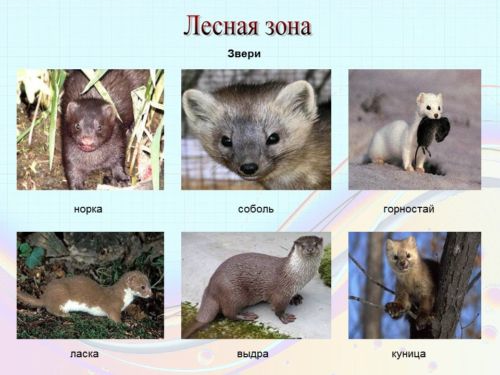
pictures depicting animals of the forest zone.
Source 3.
Brown bear. In appearance, the brown bear is clumsy, although in reality it is very mobile and agile: it can run fast, make big jumps, climb trees, and swim. He walks through the forest carefully and almost silently. In calm times, he walks slowly, putting his feet slightly inward, justifying the popular name "clubfoot". Another name "bear" is due to the fact that this beast loves honey very much and knows (knows) where to look for it. Behind him, he climbs high trees into hollows with honeycombs of wild bees, often raids apiaries. The forest provides the bear with abundant and varied food.
By autumn, the bears grow fat, accumulating nutrients in the body for the period of winter starvation. Most bears in the den fall into a state of winter sleep, not needing food or drink. However, it is widely believed that bears, being in a den without food, suck their paws in order to extract nutritious juices from them and satisfy their hunger. In fact, this is a misunderstanding, here the reason is different. In bears, approximately in February, flaking occurs from the surface of the soles of the old skin that has coarsened over the summer. The young, tender skin on the paws itches and freezes, so the bear licks the soles with a hot tongue, smacking his lips. That is why from the side it seems that the bear is sucking its paw. Bears are afraid of a man and, smelling his smell, go into a deaf thicket. Attacks on humans are very rare.
Tiger - one of the most beautiful animals on earth. People admire the tiger, admire it and even fear it - after all, it is the largest of all felines and the most ferocious predator. Amur tigers are the largest. The weight of an adult male reaches up to 400 kg. Amur tigers are also unique in that, unlike their counterparts living in the hot tropics, they have chosen taiga forests for themselves. Wild boars, elk and red deer become prey for taiga tigers.
Elk , nicknamed elk - one of the most famous inhabitants of taiga and mixed forests. Clumsy, long-legged, hook-nosed, moose bear little resemblance to graceful deer. However, the elk is a deer, and the largest. In summer, the elk feels almost safe. During this satisfying time, its main enemies - wolves and bears - can find easier prey. But in winter, moose have a hard time. At this time, hungry wolves huddle in packs and a bear - a connecting rod prowls in search of any prey. In addition, moose shed their antlers in winter. True, the antlers serve the moose not only as a means of protection, but as a tournament weapon in fights for the female. But even a hornless elk is not so defenseless - a powerful blow of a large front hoof is quite capable of cracking a wolf's skull.
Kedrovka. These birds are especially numerous in the coniferous forests of Siberia. In size, they are slightly smaller than the jackdaw. They live in packs and lead a sedentary lifestyle. Until cones ripen, Nutcrackers feed on forest insects, their larvae, berries, and later on pine nuts and spruce seeds. For the winter, they arrange pantries, then looking for them under the snow, even at a depth of half a meter. In the nesting period, they climb into a dense thicket, arranging nests at a height of 4-6 m. The clutch usually consists of 3-5 eggs. Incubation lasts more than half a month. After 3-4 weeks, the chicks can already leave the nest. Nutcrackers are of great benefit, contributing to the resettlement of cedar over large areas.
Cuckoo. This small bird is somewhat smaller than a dove. The presence of a cuckoo is easily detected by the characteristic singing of males. Only males cook! Females cannot cuckoo. The cuckoo does not build nests. During the spring, the female lays 10-20 eggs, and with large intervals of time, and throws them into other people's nests. Interestingly, in color, size and shape, the cuckoo's egg is very similar to the egg of the bird in whose nest she throws it. Adult and juvenile cuckoos feed on insects, in particular eating many hairy caterpillars that other birds avoid. A cuckoo eats 39 grasshoppers, 43 cabbage caterpillars, 5 Maybug larvae, 4 spiders, 3 butterfly pupae per day.
Source 4.
Do you know?
An owl kills about 1,000 rodents a year. If we take into account that each mouse can eat 1 kg of grain per year, then one owl will save 1 ton of bread per year!
The cuckoo has an extraordinary appetite: in an hour it can eat a hundred caterpillars. If a large number of insect pests appear in the forest, then she cracks down on them within a few days.
Bats are of great benefit by destroying harmful insects. They clear the area of malarial mosquitoes. During an hour of night hunting, a bat can catch and eat 160-170 mosquitoes.
It turns out that tigers have striped not only fur, but also skin. And, by the way, the pattern of these stripes is unique for each individual, like human fingerprints. And on each of the front paws of this predator there are five fingers, while on the back - only four. By the way, the night vision of these mighty predators is 6 times better than that of humans, thanks to the reflection mechanism.
Source 5.
From the life of animals. dramatization "Why does the hedgehog sleep all winter, but the bunny does not."
I envied Mishka, -
once a hedgehog said to a bunny ,
In the bitter cold, in the snow, in the blizzard
He sleeps to himself and not gu-gu!
Nonsense -said the bunny.
Sleeping all winter is too much!
And besides, you notice
No one is sleeping - a bear!
And I'll fall asleep for a long time,
So I'll wake up in the teeth of a wolf.
No, my life is dearer to me
Yes, and you, brother, do not lie down.
Case number 4 for ecologists: (Slide 10)
Your task, working in a group, is to find out:
Card - support with questions:
What environmental problems are there in the forest natural zone?
Who can destroy the forest? What needs to be done to prevent this from happening?
3) What is being done to protect nature?
Source 1.
Attextbook by O.T. Poglazov "The world around" (pp. 130-131)
Source 2.
There are many wonderful poems about the kind, reverent attitude of a person to the forest, which testifies to the love of a Russian person for his native nature. But, unfortunately, the sign of today is the appearance of these verses:
The forests are leaving, I feel sorry for the forests.
Spruces, pines and birches are leaving,
Mountain ash extinguishes fiery clusters,
Oaks once lived in those forests
And ash and golden maples
Where can they escape such a fate?
The forest is being cut down, the ocean is green!
Causes of deforestation on our planet: logging, fires, air pollution, littering of forests, the impact of recreation and tourism.
Tropical forests, the most significant for the biosphere, have already been destroyed by 40%, and the rest are cut down at a rate of 20 hectares per minute.
As a result of the accident at the Chernobolsk nuclear power plant, 2.1 million hectares of forests were affected.
As a result of massive cuttings and fires in the 17th century, the forest cover decreased to 53%, in the 18th century - to 30%, in the 19th century - to 30%, in the 20th century - to 24%. What awaits us in the 21st century? How can this be avoided?
Forgetful hunter at rest
Did not sweep, did not trample the fire.
He went into the forest, and the branches were burning down
And they reluctantly smoked until the morning ...
And in the morning the wind dispersed the mists,
And the dying fire came to life.
And, pouring sparks in the middle of the clearing.
Crimson tatters spread out.
He burned all the grass with flowers together,
He burned the bushes, went into the green forest.
Like a frightened flock of red squirrels,
He swung from barrel to barrel.
And the forest hummed from a fiery blizzard,
Trunks fell with a frosty crack,
And how, snowflakes, sparks flew from them
Above the gray drifts of ash.
Terrible fire in the forest. Plants, animals, birds die. Sometimes fires themselves arise in the forest from lightning strikes, but more often the cause of their occurrence is a person, or rather, a person’s careless handling of fire.
Man is not only the cause of fires. Our smaller brothers die every day under gunshots.
Shoot the bird, shoot the beast
And with each shot, there are less and less animals ...
Nature brings us with childlike trust
Not only booty, bring yourself.
The getter shoots, and does not know the measure,
Here again the hand reached for the gun.
He does not hear the fox crying over the fox.
The hare will no longer see her son,
Like an elk trumpets our farewell song
And how the forest groaned with every branch.
Pieces of nature will no longer be resurrected,
A cut will be baked in the blood on the heart.
Source 3.
– We have received complaints. Understand who is complaining, how to help.
I live in the tropical steppe, I can't fly, although I'm a bird, but I can run fast. The length of my step is 2 meters, but still they catch up with us and exterminate us. It's our precious feathers that are to blame. Have pity on us, please.
In the summer we love to bask in the sun. Completely safe for humans. We eat insects or small animals. We have an amazing feature - we leave our tail in the hands of the "attacker" on us. Interesting? And they hit us with a stick on the head
We interfere with everything. Here I am - only 16 kg of grain have been stored in a mink and I sleep, I don’t touch anyone. And they call me a pest and a plunderer. Not fair!
– Who are these animals complaining about?What should these people be called?
Source 4.
Environmental problems of the forest zone:
extinction of animals and plants;
poaching;
environmental pollution;
soil destruction by machinery;
deforestation;
fires;
Troubleshooting: creation of reserves
prohibition of hunting
restriction of fishing
take care of natural resources
restoration of deforested areas
fire prevention
Source 5.
Plants and animals of forests listed in the Red Book. (Appendix 1)
Consolidation.
Show discussion options. Performances of groups (geographers, botanists, zoologists and ecologists).
1. Listen to the solution to the problem of each group.
2. At the same time, the acquired knowledge is corrected, refined, supplemented.
3. Finding the optimal solution to the ecological problem of the forest zone.
Reflection. Summary of the lesson.
What time of year do we have now?
We miss the summer, autumn forest, when the forest is "clothed with foliage." Let's turn into wizards for a moment and give the tree its foliage:
– If you were interested, if you learned a lot and actively worked - a green leaf.
– If you want to be more active in the lesson, then yellow.
– If you were not interested, then leave the branch without a leaf.
After listening to the statements, answer them with + signs if you agree and - if you don't.
The forest zone stretches from the west to the east of Russia.
The forest zone has cold summers and hot winters.
A brown bear lives in the forest zone.
Forest plants are herbaceous plants, shrubs, trees.
In plants of the forest zone, the root is represented by a long rhizome, root bundles.
The color of animal forests is bright, catchy, noticeable from afar.
The cuckoo is a forest bird.
The following are listed in the Red Book: the Amur tiger, the river beaver, the crane.
There are no environmental problems in the forest.
Who can sum up the lesson and draw a conclusion?The forest zone is located south of the tundra, it is colored green on the map, the climate is humid ...
9. Homework
In the next lesson, we will continue talking about the relationship between the forest and man.
Homework page 130-131, workbook page 34, assignment No. 8, No. 9, with an asterisk if desired.
Appendix 1.
Plants and animals of the forest zone, listed in the Red Book
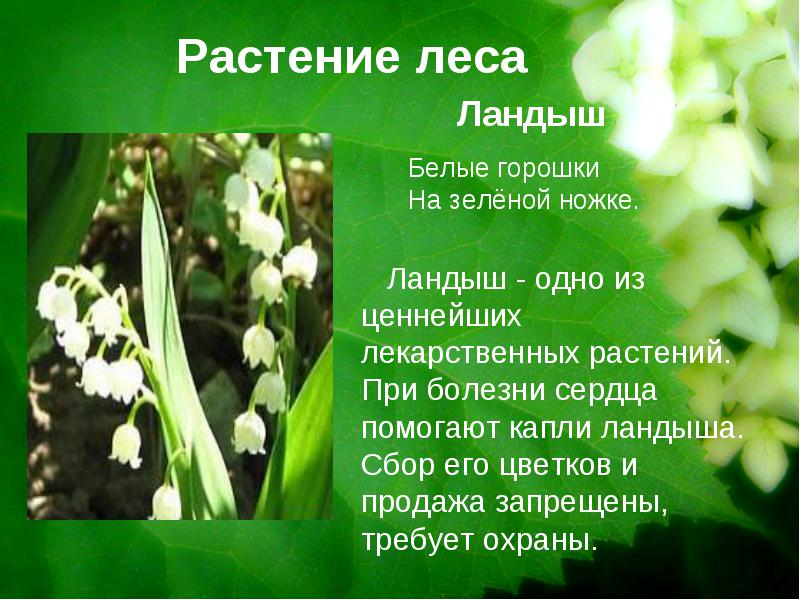
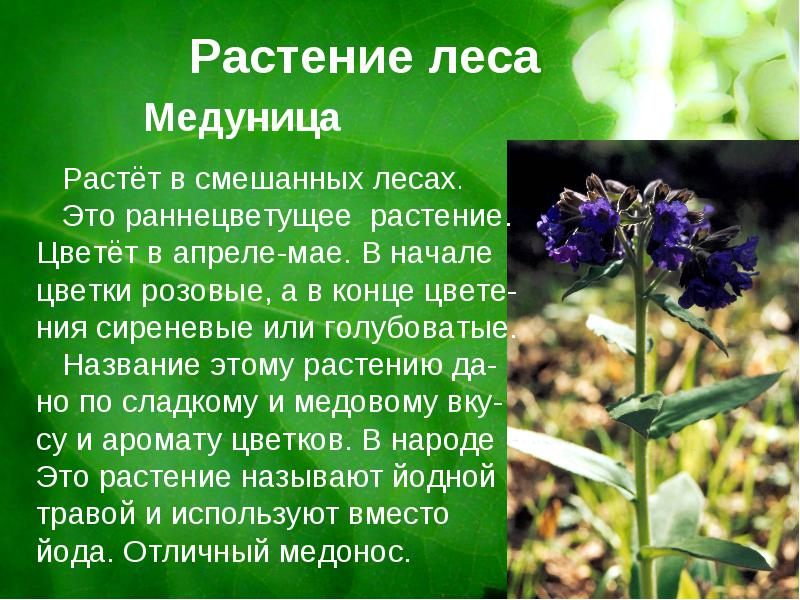
Name the animals.
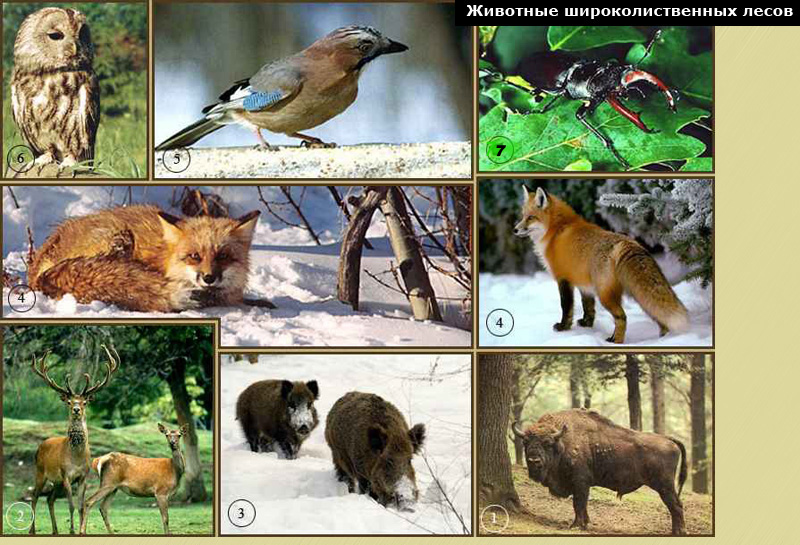
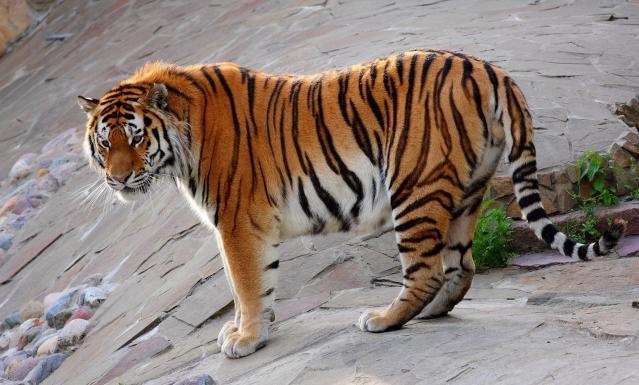
Amur tiger
